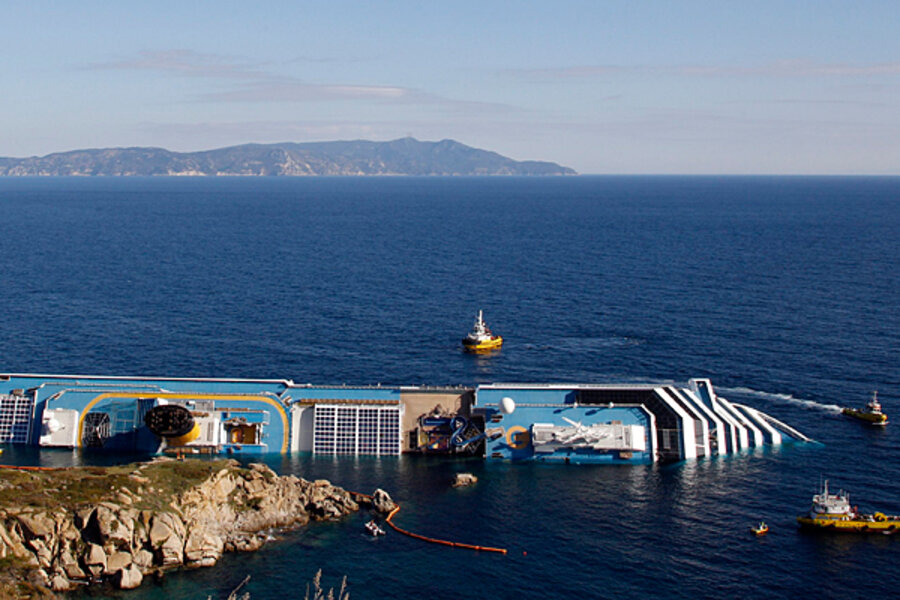After airing false footage of Costa Concordia, Italian media under fire
Loading...
| Milan, Italy
While the search for victims in Friday's cruise ship wreck off the Italian coast continues, with rescue squads blowing holes in the sides of the ship to provide escape routes for anyone still trapped, the media frenzy has raised questions about journalistic ethics and practices in Italy, where entry into the profession is tightly controlled.
Given slip-ups by established news outlets, bloggers say that the rules limiting membership should no longer be tolerated.
At least 11 have died in the Costa Concordia wreck and at least 29 more people are missing after the ship's hull was torn open when it ran aground off the coast of Tuscany, causing the 4,000-passenger vessel to keel over. The ship's captain, Francesco Schettino, is under arrest and may face charges that include manslaughter, shipwreck, and abandoning a ship when passengers were still on board, according to news reports. He faces up to 15 years in prison.
On Monday, the cruise ship company Costa Crociere, which owns the Costa Concordia and is Italy's leader in luxury cruises, accused Captain Schettino of deviating from a computerized route and of abandoning the ship before the evacuation has been completed. Company President Pier Luigi Foschi said in a press conference that his firm will take part into the trial as "parte lesa," meaning it will side with the accuser and ask for compensation.
[ Video is no longer available. ]
Although Schettino's fate is front and center, the poor quality of the initial reporting has put the country's once powerful Ordine dei Giornalisti – known in English as the Italian National Order of Journalists – under fire as well, prompting questions about the necessity of having a national organization regulate the journalism profession – an increasingly unpopular concept. Critics say coverage of the Costa Concordia is proof that it hasn't been very effective.
On Jan. 15, the state-owned television news channel Rai broadcast footage showing the interior of a luxury cruise ship shaking while passengers panicked. The images actually came from a video posted on YouTube on Sept. 8, 2010 that was filmed on an Australian cruise ship sailing in the Pacific Ocean, according to the person who uploaded it.
Italian bloggers quickly uncovered the fake and demanded that the National Order of Journalists – the powerful body issuing “journalism patents” that are formally necessary to enter the profession – take steps against Rai. This morning Linkiesta, one of the most influential collective blogs in Italian language, asked Order president Enzo Iacopini to take responsibility for the incident.
The criticism comes as the Order tries to resist government pressure to ease restrictions on entering the journalism industry. Current laws, such as a mandatory exam, limit the number of people practicing journalism in Italy, but the current left-leaning government is trying to abolish some of the restrictions to bring Italy more in line with European standards.
In Italy, journalists must pass a government-supervised exam and register in the Order to enter the profession. The government is planning to ease up on those requirements as part of an economic liberalization package that will also ease restrictions on many other professions.
Mr. Iacopini argues that the restrictions are crucial to ensuring a fair and balanced press coverage, but many Italians – especially bloggers, weary of the Order's control of the industry – argue that the video hoax proves the opposite. “Those who have broadcasted the fake video were registered journalists. Those who unmasked it were not," said Jacopo Tondelli, chief blogger at Linkiesta. "Even after the Internet – often snobbed by professional journalism – had quickly uncovered the fake video of a cruise ship sold as the [Costa] Concordia, national news kept broadcasting the video as if it were a live documentation of that tragedy – some of them."
Iacopini told The Christian Science Monitor that such incidents should not raise doubts about the necessity of the Order. “It's like saying that because there are people who can drive without a driving license, and vice versa, we should abolish driving licenses,” he says, adding that those responsible for airing the fake video may face sanctions.
The anger toward the Order is unjustified in such a short period of time, he says. “Did they expect us to act within hours? We need time, it's an inquiry, not a Stalinist trial”
While the Order faces fire, some say that the mistake by Rai actually show the need for more regulation.
“Of course the laws regulating journalism are old and need to be updated," says Franco Abruzzo, a professor of journalism at the Bicocca University of Milan. "But if people, in this case journalists, don't follow the rules, we should not say 'Let's abolish the rule.' We should enforce them.”







